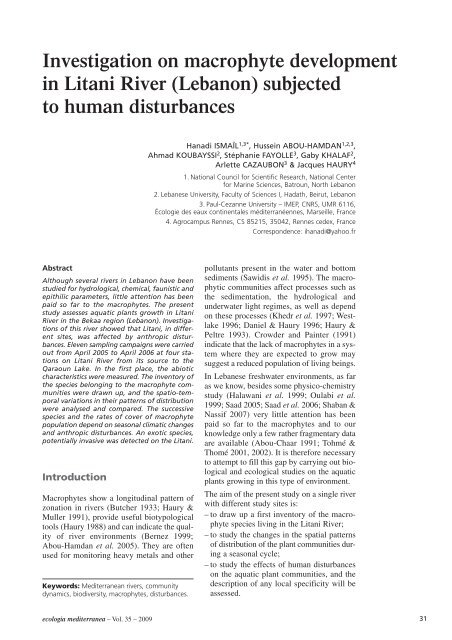Vol. 35 – 2009 - Ecologia Mediterranea - Université d'Avignon et des ...
Vol. 35 – 2009 - Ecologia Mediterranea - Université d'Avignon et des ...
Vol. 35 – 2009 - Ecologia Mediterranea - Université d'Avignon et des ...
You also want an ePaper? Increase the reach of your titles
YUMPU automatically turns print PDFs into web optimized ePapers that Google loves.
Investigation on macrophyte development<br />
in Litani River (Lebanon) subjected<br />
to human disturbances<br />
Abstract<br />
Although several rivers in Lebanon have been<br />
studied for hydrological, chemical, faunistic and<br />
epithilic param<strong>et</strong>ers, little attention has been<br />
paid so far to the macrophytes. The present<br />
study assesses aquatic plants growth in Litani<br />
River in the Bekaa region (Lebanon). Investigations<br />
of this river showed that Litani, in different<br />
sites, was affected by anthropic disturbances.<br />
Eleven sampling campaigns were carried<br />
out from April 2005 to April 2006 at four stations<br />
on Litani River from its source to the<br />
Qaraoun Lake. In the first place, the abiotic<br />
characteristics were measured. The inventory of<br />
the species belonging to the macrophyte communities<br />
were drawn up, and the spatio-temporal<br />
variations in their patterns of distribution<br />
were analysed and compared. The successive<br />
species and the rates of cover of macrophyte<br />
population depend on seasonal climatic changes<br />
and anthropic disturbances. An exotic species,<br />
potentially invasive was d<strong>et</strong>ected on the Litani.<br />
Introduction<br />
Macrophytes show a longitudinal pattern of<br />
zonation in rivers (Butcher 1933; Haury &<br />
Muller 1991), provide useful biotypological<br />
tools (Haury 1988) and can indicate the quality<br />
of river environments (Bernez 1999;<br />
Abou-Hamdan <strong>et</strong> al. 2005). They are often<br />
used for monitoring heavy m<strong>et</strong>als and other<br />
Keywords: <strong>Mediterranea</strong>n rivers, community<br />
dynamics, biodiversity, macrophytes, disturbances.<br />
ecologia mediterranea <strong>–</strong> <strong>Vol</strong>. <strong>35</strong> <strong>–</strong> <strong>2009</strong><br />
Hanadi ISMAÏL 1,3* , Hussein ABOU-HAMDAN 1,2,3 ,<br />
Ahmad KOUBAYSSI 2 , Stéphanie FAYOLLE 3 , Gaby KHALAF 2 ,<br />
Arl<strong>et</strong>te CAZAUBON 3 & Jacques HAURY 4<br />
1. National Council for Scientific Research, National Center<br />
for Marine Sciences, Batroun, North Lebanon<br />
2. Lebanese University, Faculty of Sciences I, Hadath, Beirut, Lebanon<br />
3. Paul-Cezanne University <strong>–</strong> IMEP, CNRS, UMR 6116,<br />
Écologie <strong>des</strong> eaux continentales méditerranéennes, Marseille, France<br />
4. Agrocampus Rennes, CS 85215, <strong>35</strong>042, Rennes cedex, France<br />
Correspondence: ihanadi@yahoo.fr<br />
pollutants present in the water and bottom<br />
sediments (Sawidis <strong>et</strong> al. 1995). The macrophytic<br />
communities affect processes such as<br />
the sedimentation, the hydrological and<br />
underwater light regimes, as well as depend<br />
on these processes (Khedr <strong>et</strong> al. 1997; Westlake<br />
1996; Daniel & Haury 1996; Haury &<br />
Peltre 1993). Crowder and Painter (1991)<br />
indicate that the lack of macrophytes in a system<br />
where they are expected to grow may<br />
suggest a reduced population of living beings.<br />
In Lebanese freshwater environments, as far<br />
as we know, besi<strong>des</strong> some physico-chemistry<br />
study (Halawani <strong>et</strong> al. 1999; Oulabi <strong>et</strong> al.<br />
1999; Saad 2005; Saad <strong>et</strong> al. 2006; Shaban &<br />
Nassif 2007) very little attention has been<br />
paid so far to the macrophytes and to our<br />
knowledge only a few rather fragmentary data<br />
are available (Abou-Chaar 1991; Tohmé &<br />
Thomé 2001, 2002). It is therefore necessary<br />
to attempt to fill this gap by carrying out biological<br />
and ecological studies on the aquatic<br />
plants growing in this type of environment.<br />
The aim of the present study on a single river<br />
with different study sites is:<br />
<strong>–</strong> to draw up a first inventory of the macrophyte<br />
species living in the Litani River;<br />
<strong>–</strong> to study the changes in the spatial patterns<br />
of distribution of the plant communities during<br />
a seasonal cycle;<br />
<strong>–</strong> to study the effects of human disturbances<br />
on the aquatic plant communities, and the<br />
<strong>des</strong>cription of any local specificity will be<br />
assessed.<br />
31
















